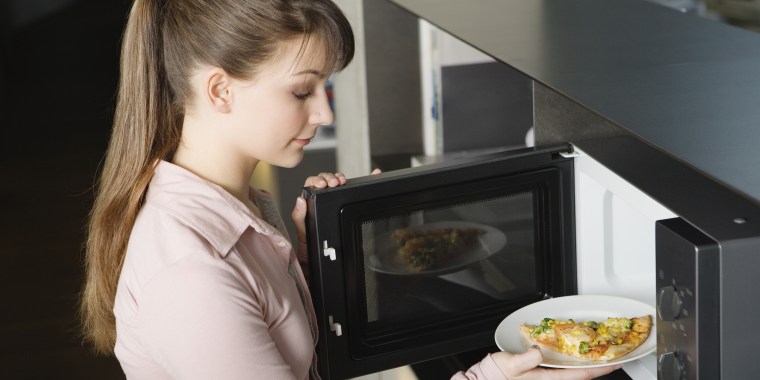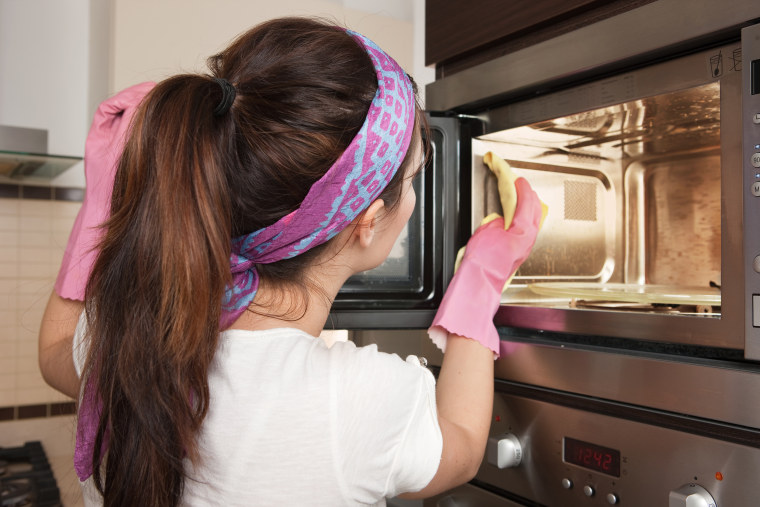When sparks fly, it's usually a sign of romance — unless they're coming from the microwave.
Have you ever accidentally microwaved something with metal in it? Or accidentally microwaved leftovers covered with plastic wrap only to find a nice dish filled with melted plastic stew? Unfortunately, there are a lot of ways to easily screw up your food when nuking it.
But you're not alone in making them.
Janell Goodwin, technical information specialist with the U.S. Department of Agriculture's Food Safety Inspection Service, dished on several common problems people face when using this popular kitchen appliance.

Mistake 1: Skipping the "stir halfway through" step
Even if there's a line behind you at the office to use the microwave, make sure to press pause about halfway through the reheating process. It's crucial to mix up your food to ensure that the heat is reaching all parts of the dish. Cold centers and uneven reheating can lead to a forkful of bacteria.
"Items microwave from the outside in. We recommend to rotate and stir food in the microwave halfway through," Goodwin told TODAY Food. "Harmful bacteria grow and multiply between degrees 40 and 140 degrees. That's exactly what that center can be."
Mistake 2: Using plastic because who wants a dirty dish?
"Many people think that containers like takeout containers are OK for the microwave. They're not," Goodwin said. "Harmful bacteria and chemicals can migrate into the food when they warp or melt." Goodwin advised using only microwave-safe containers that are properly labeled.
Mistake 3: Not knowing the wattage of the device
Wattage, though sometimes difficult to determine, is actually a key factor in heating food safely. Goodwin advised microwave users to call the manufacturer or look up the model online to figure out its wattage. The higher the wattage (most medium to large microwaves are between 850 and 1,650 watts), the faster the food cooks. So if a dish normally takes about 2 minutes to reheat, in a low-wattage machine, it might need to cook for longer. Every device is different, but it's best to start out slowly so as not to dry out and overcook those leftovers.
Mistake 4: Not cleaning it. Ever.

Not only does routine microwave cleaning kill off bacteria left behind from food, it's important to keep any device in the kitchen clean, Goodwin advised.
"After 32 hours, bacteria is no longer able to spread on a surface," Goodwin said.
It's a good idea to wipe both the inside and outside of the microwave with a soft cloth or paper towel moistened with warm water and baking soda, or dish or liquid soap. It keeps the area free of residue and the kitchen smelling fresh. Plus, leftover food particles won't contaminate your fresh dishes.
Mistake 5: Defrosting meat right in its package
Microwaving raw meat right in the package might seem like a good way to contain messy meat juices, but it can actually be more harmful than unwrapping it first. Chemicals from the foam trays meat is sold on and the plastic from the wrap can seep into your food as both heat up.
The FSIS always advises unwrapping meat from its package before defrosting it to avoid the leakage from harmful chemicals often found in Styrofoam or plastic.
It's also important to reduce the heat to 30 percent or hit the "defrost" setting when defrosting meats and poultry in the microwave. Cooking the meat entirely can be done, but if that viral Thanksgiving prank taught people anything, the oven is really your best bet for a big roast.
Mistake 6: Sometimes using the microwave as a dryer
Perhaps the seemingly ingenious hack of quickly nuking those damp gloves or socks has come to mind at one time or another. Please don't do this, Goodwin said, as the material from non-food items can be a fire hazard.
"That is just not what a microwave is intended to do," Goodwin said.
Mistake 7: Covering food the wrong way
Since heat circulates, keeping food covered lightly helps ensure that the dish reheats evenly, doesn't overcook and tastes better. The moist heat created when food is steamed or vented with a lid that's not too tight also helps destroy harmful bacteria.
Though it's always a good idea to cover food when reheating it in the microwave (otherwise that cleaning schedule will be on overdrive), microwaving food in an airtight container is a no-no. When microwaved, completely closed, lids can become impossible to open (say goodbye to lunch). Or worse, if the container is full of liquid, it can explode.
Mistake 8: Reheating hard-boiled eggs and other foods
Microwaving hard-boiled eggs in their shells is pretty dangerous, because they can easily explode. Not only will you have a stinky mess, but your meal will be ruined.
"You would also lose the overall texture of the egg. It would be come rubbery and not good to eat," Goodwin said.
And nobody — nobody — likes a rubbery egg.
The microwave is an undeniably convenient machine, but it's not always the best way to ensure great-tasting leftovers. If you're at home, it's OK to take a few extra minutes to properly warm certain types of foods. Reheating seafood in a microwave is a recipe for a dry disaster, so try reheating it slowly in the oven. Pizza crusts crisp up nicely in a hot pan or the oven, too!
